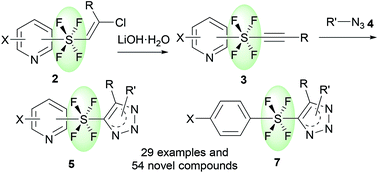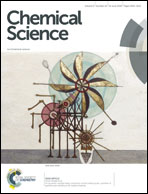An eccentric rod-like linear connection of two heterocycles: synthesis of pyridine trans-tetrafluoro-λ6-sulfanyl triazoles†
Abstract
The trans-tetrafluoro-λ6-sulfane (SF4) group has been utilized as a unique three-dimensional building block for the linear connection of two independent N-heterocycles, pyridines and triazoles. The linearly connected heterocyclic compounds were synthesized by thermal Huisgen 1,3-dipolar cycloaddition between previously unknown pyridine SF4-alkynes and readily available azides, providing a series of rod-like SF4-connected N-heterocycles in good to excellent yields. X-ray crystallographic analysis of the target products revealed the trans-geometry of the SF4 group, which linearly connects two independent N-heterocycles. This research will open the field of chemistry of SF4-connected heterocyclic compounds.



 Please wait while we load your content...
Please wait while we load your content...